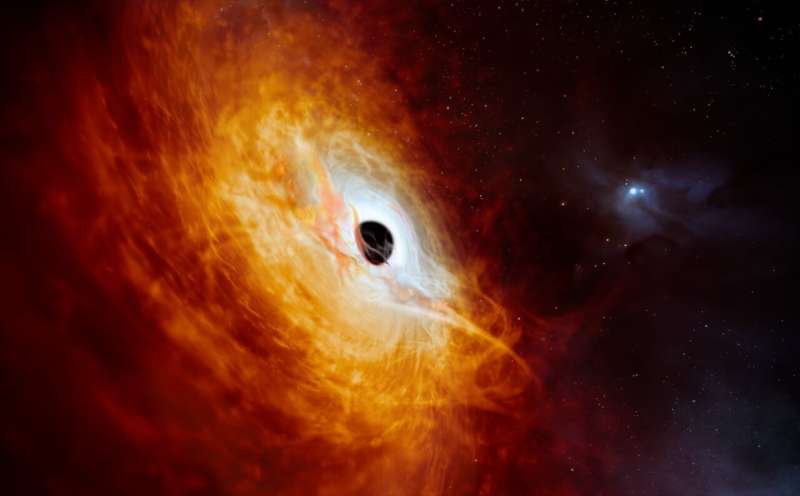Record-breaking quasar identified as the brightest and fastest-growing by astronomers

Article Date: February 19, 2024
This article has undergone rigorous review in keeping with Science X's editorial policy and process. Among the measures taken to ensure content credibility, the following stand out:
- Fact-checking
- A peer-reviewed publication
- Recourse to a trusted source
- Proofreading
Endorsement by the ESO
Astronomers armed with the European Southern Observatory's (ESO) Very Large Telescope (VLT) have successfully profiled a bright quasar. Their findings reveal not only an exceptionally bright quasar but also the most extraordinarily bright object ever observed. These quasars, which are bright cores of distant galaxies, are powered by supermassive black holes.
The black hole at the heart of the record-breaking quasar is growing speedily in mass to the tune of a sun a day, earning it the title of the fastest-growing black hole yet discovered.
The black holes that power quasars gather matter from their surroundings in a high-energy process that shines incredibly brightly. Indeed, quasars are among the most radiant objects in our sky, making them detectable from Earth even when they are distant. It tends to be that the brightest quasars have the fastest-growing supermassive black holes.
"Undoubtedly, we have discovered the fastest-growing black hole currently known. Weighing 17 billion suns, it consumes slightly more than one sun daily. This certainly makes it the brightest object in the known universe," shares Christian Wolf, an astronomer at the Australian National University (ANU) and the study's primary author, published in Nature Astronomy. The quasar, known as J0529-4351, is located at such a vast distance from Earth that its light took over 12 billion years to reach us.
The matter being sucked into the black hole, forming a disk, discharges so much energy that J0529-4351 glows over 500 trillion times brighter than our sun. ANU Ph.D. student and co-author Samuel Lai reveals, "All this radiance comes from a gigantic accretion disk, seven light-years across—the largest known in the universe." To put that in perspective, seven light-years equates to about 15,000 times the distance from our sun to Neptune's orbit.
Strikingly, this record-breaking quasar was hidden in plain sight. Christopher Onken, an ANU astronomer, and another co-author of the study explains, "It's surprising that it remained unidentified until now when we have already discovered about a million less remarkable quasars. It's essentially been right under our noses,". He also added that this object appeared in images from the ESO Schmidt Southern Sky Survey as far back as 1980 but remained undetected as a quasar until much later.
Quasar identification requires meticulous observational data from extensive sky territories. The resultant datasets are so extensive that scientists frequently rely on machine learning models to sift through them and distinguish quasars from other space objects.
Unfortunately, these models are trained on existing data, and can thus only identify objects similar to known ones. This implies that a novel quasar, emitting more light than any seen before, could be incorrectly dismissed as a nearby star.
An automatic analysis of data from the European Space Agency's Gaia satellite overlooked J0529-4351, deeming it too bright to be a quasar, and suggested it was a star instead. However, last year, the researchers pinned it as a remote quasar using observations from the ANU 2.3-meter telescope at the Siding Spring Observatory in Australia.
But pinning it as the most luminous quasar encountered so far required a larger telescope and more accurate tools. Crucial data was provided by the X-shooter spectrograph installed on the ESO's VLT located in the Chilean Atacama Desert.
An upgrade to the GRAVITY+ on ESO's VLT Interferometer (VLTI) will make the fastest-growing black hole an ideal target for accurate measurements of its mass, no matter how far from Earth it is. The Extremely Large Telescope (ELT) by ESO, currently under construction in the Atacama Desert, will improve the ease of identifying and characterizing such elusive celestial objects.
Detecting and examining such distant supermassive black holes might reveal secrets about the early universe, including how these black holes and their host galaxies were formed and evolved. Christian Wolf reveals a more personal motivation, saying, " Personally, I simply enjoy the chase,' he says. 'For a few minutes a day, I get to feel like a child again, playing treasure hunt, and now I bring everything to the table that I have learned since."
Credit for information: The Journal–Nature Astronomy and provided by ESO.




